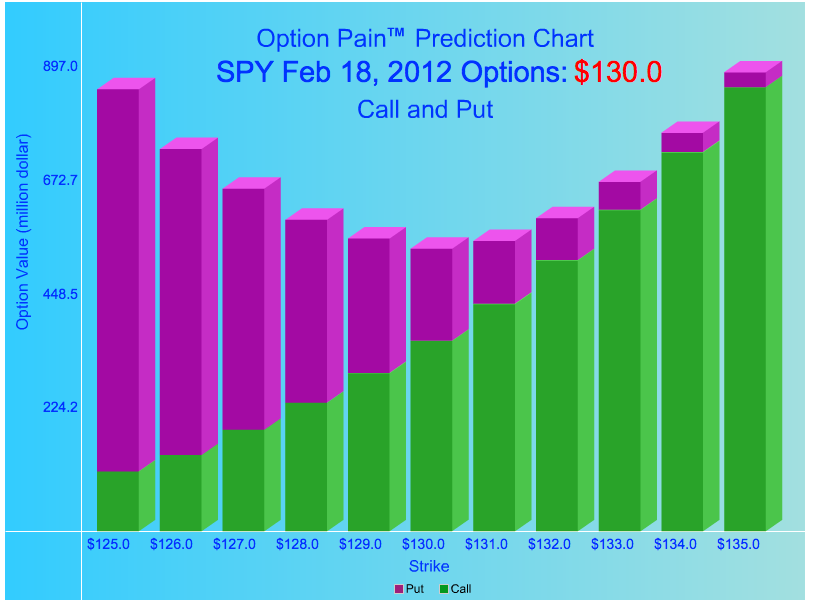The “Max Pain” theory, also sometimes called the Strike Price Pegging, as it relates to options trading refers to the changes in the price of an underlying stock as it gets closer to its option expiration date.
According to the theory, most traders trading options are likely to experience painful losses on average over time. Thus, the stock will tend to move to an area that causes the most pain (i.e. losses) for the highest number of options traders.
Stocks Move Toward The Middle
The maximum pain theory assumes that most of the option contracts (Calls or Puts) will expire worthless on the option expiry date. What happens is that during the last few days of trading for the month, the price of the underlying stock will move toward the pain point.
This strike price is the value where most option traders will lose their money as the options expire worthless, causing everyone long to go broke.
A Simple But Powerful Illustration
For example, let’s say that a Call option contract for a company, named ABC, costs $200 premium and has a strike price of $40. It has an expiration date of one month out or 30 days. The trader strongly believes that the stock will rise in the coming month. Therefore, he purchases the call option by paying the $200 premium.
And let’s say that yet another trader bought a Put option contract because he felt that the stock price will fall within the coming month. He purchased the put option by paying the premium at the time; $200 per contract.
If the stock closes at $40, the Max Pain Price, both the call and put options would expire with a value of $0.00. This is the point at which both traders (long and short) would lose money. Make sense now?
Here’s Option Max Pain Calculator
A really great website and tool to help determine the strike prices that are likely to cause the most pain is OptionPain.com. There you can literally type in the ticker symbol, expiration month, and strike price range and it will visually show you where the stock is likely to close to cause most option buyers to lose money.
In the example above I used the SPY February contract which expires next week to show you what it looks like visually. Right now it shows us that the max pain point would be for the SPY to close around $130. Since it’s currently trading at $134 this would mean a sizable decline in the next week.
Again this is an awesome tool to check out for all your open positions as you near expiration.
Theory Is Of Course Just Theory
Especially when it comes to the stock and options market, nothing is certain. I’ve seen this work in both directions in the past – sometimes to surprising accuracy. Should you base your entire expiration week strategy on this; No. But you should at least be aware of it after all.
Enough of my thoughts on this subject…Do you think this theory works? Have you had success with it before? Add your comments below and share your experiences.
- English (UK)
- English (India)
- English (Canada)
- English (Australia)
- English (South Africa)
- English (Philippines)
- English (Nigeria)
- Deutsch
- Español (España)
- Español (México)
- Français
- Italiano
- Nederlands
- Português (Portugal)
- Polski
- Português (Brasil)
- Русский
- Türkçe
- العربية
- Ελληνικά
- Svenska
- Suomi
- עברית
- 日本語
- 한국어
- 简体中文
- 繁體中文
- Bahasa Indonesia
- Bahasa Melayu
- ไทย
- Tiếng Việt
- हिंदी
Understanding The Max Pain Theory Near Options Expiration
Published 02/10/2012, 04:00 AM
Updated 07/09/2023, 06:31 AM
Understanding The Max Pain Theory Near Options Expiration
3rd party Ad. Not an offer or recommendation by Investing.com. See disclosure here or
remove ads
.
Latest comments
Install Our App
Risk Disclosure: Trading in financial instruments and/or cryptocurrencies involves high risks including the risk of losing some, or all, of your investment amount, and may not be suitable for all investors. Prices of cryptocurrencies are extremely volatile and may be affected by external factors such as financial, regulatory or political events. Trading on margin increases the financial risks.
Before deciding to trade in financial instrument or cryptocurrencies you should be fully informed of the risks and costs associated with trading the financial markets, carefully consider your investment objectives, level of experience, and risk appetite, and seek professional advice where needed.
Fusion Media would like to remind you that the data contained in this website is not necessarily real-time nor accurate. The data and prices on the website are not necessarily provided by any market or exchange, but may be provided by market makers, and so prices may not be accurate and may differ from the actual price at any given market, meaning prices are indicative and not appropriate for trading purposes. Fusion Media and any provider of the data contained in this website will not accept liability for any loss or damage as a result of your trading, or your reliance on the information contained within this website.
It is prohibited to use, store, reproduce, display, modify, transmit or distribute the data contained in this website without the explicit prior written permission of Fusion Media and/or the data provider. All intellectual property rights are reserved by the providers and/or the exchange providing the data contained in this website.
Fusion Media may be compensated by the advertisers that appear on the website, based on your interaction with the advertisements or advertisers.
Before deciding to trade in financial instrument or cryptocurrencies you should be fully informed of the risks and costs associated with trading the financial markets, carefully consider your investment objectives, level of experience, and risk appetite, and seek professional advice where needed.
Fusion Media would like to remind you that the data contained in this website is not necessarily real-time nor accurate. The data and prices on the website are not necessarily provided by any market or exchange, but may be provided by market makers, and so prices may not be accurate and may differ from the actual price at any given market, meaning prices are indicative and not appropriate for trading purposes. Fusion Media and any provider of the data contained in this website will not accept liability for any loss or damage as a result of your trading, or your reliance on the information contained within this website.
It is prohibited to use, store, reproduce, display, modify, transmit or distribute the data contained in this website without the explicit prior written permission of Fusion Media and/or the data provider. All intellectual property rights are reserved by the providers and/or the exchange providing the data contained in this website.
Fusion Media may be compensated by the advertisers that appear on the website, based on your interaction with the advertisements or advertisers.
© 2007-2024 - Fusion Media Limited. All Rights Reserved.
